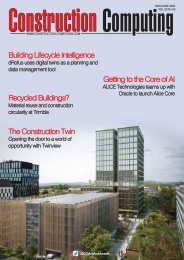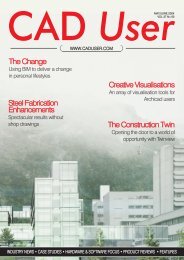You also want an ePaper? Increase the reach of your titles
YUMPU automatically turns print PDFs into web optimized ePapers that Google loves.
TECHNOLOGY focus<br />
Deep Learning<br />
Enscape's association with NVIDIA on its latest Graphics Cards featuring DLSS technology<br />
boosts the company's real-time rendering capabilities<br />
It's not so long ago that you had to resort<br />
to 'render farms' to turn your 3D models<br />
and animations into lifelike images.<br />
There was a step change up from that<br />
time-consuming process when computers<br />
with more powerful or multithreaded CPUs<br />
became available, and you merely had to<br />
pop off for lunch when you got to the<br />
rendering stage. Graphics cards have<br />
advanced considerably, and it became<br />
obvious that NVIDIA had product and<br />
technology goals which they saw they<br />
could achieve through a specific avenue of<br />
hardware/software development. They<br />
executed successfully on that strategy -<br />
and updated their capabilities dramatically.<br />
With more powerful GPUs and increased<br />
frame buffer sizes, NVIDIA claims that they<br />
can now be used to accelerate the<br />
rendering process by up to 6 or 15 times<br />
compared to what is achievable using the<br />
fastest CPUs. A graphics workstation's<br />
CPU features a small quantity of highly<br />
complex cores, compared to the hundreds<br />
or thousands of smaller and simpler cores<br />
on a typical GPU. Simple cores prove ideal<br />
for handling the rendering of masses of<br />
small polygons that you get in a 3D model.<br />
It is the cores in a GPU that handle the<br />
computations, and the RAM frame<br />
buffer stores pixel data so that it can be<br />
fed to a video display. VRAM stores<br />
textures and other data that are to be<br />
used in the rendering.<br />
Groundbreaking AI technology is also<br />
used by NVIDIA to increase other elements<br />
of its graphics performance. Its DLSS<br />
(Deep Learning Super Sampling)<br />
technology uses dedicated Tensor Cores<br />
on its GeForce RTX GPUs to leverage its<br />
deep learning neural network, boost frame<br />
rates and generate beautiful, sharp<br />
images in a render. Together with the RT<br />
cores ray tracing capabilities leveraging<br />
deeper tracking of individual light paths, it<br />
can simulate ultra-high resolutions and<br />
produce images comparable to native<br />
resolution even though it might only render<br />
a fraction of the pixels.<br />
The deep learning-based upscaling<br />
technology actually renders internally at a<br />
lower resolution but is able to output<br />
cleaner and sharper high-resolution<br />
images for videos and high-performance<br />
virtual reality walkthroughs.<br />
In the gaming industry, DLSS allows<br />
users to choose one of several quality<br />
modes, from Quality Performance with 4 x<br />
AI super resolution (i.e. 1080p render<br />
resolution) or Ultra-performance levels at 9<br />
x AI super resolution (1440p or 8K<br />
resolution). Whille Enscape's rendering<br />
modes are not dependent on DLSS it may<br />
be implemented in future releases.<br />
ENSCAPE<br />
Enscape, a leading provider of 3D<br />
visualisations and virtual reality technology<br />
for architects and designers, recently<br />
released Enscape 3.1, stating that,<br />
amongst other enhancements, it will be<br />
leveraging NVIDIA's DLSS technology with<br />
the new release supporting the company's<br />
RTX Graphics cards. This will enable<br />
Enscape to provide the ultimate in realtime<br />
rendering technology with lower GPU<br />
requirements, giving clients the tools to<br />
create more realistic experiences during<br />
walkthroughs and exports. Using the<br />
technology in Enscape's video rendering<br />
capabilities will mean that the reduced<br />
GPU requirements are sped up, the quality<br />
improved and visual distortions removed.<br />
The images on the opposite page show<br />
the effect of raytraced sun shadows using<br />
Enscape with and without using DLSS,<br />
and also highlight the DLSS performance<br />
enhancements at 4K and 8K resolutions<br />
and the improvements that running at 60<br />
frames per second delivers.<br />
AI IN THE AEC INDUSTRY<br />
We are all perhaps guilty of mentioning AI<br />
technology in any discussion pertaining to<br />
the construction industry lately. It's a<br />
technology, though, that can be used to<br />
enhance visualisations and innovative<br />
rendering techniques, and it is enabling<br />
rendering software developers like<br />
Enscape to both improve their<br />
photorealistic rendering capabilities and<br />
make the software easier to use.<br />
16<br />
<strong>Jul</strong>y/<strong>Aug</strong>ust <strong>2021</strong>

















